
Ground Source Heat Pumps
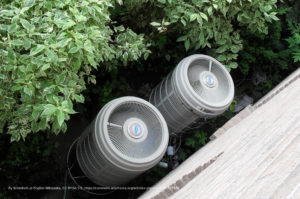 Welcome to Ground Source Heat Pumps: The Energy Efficiency Podcast – episode 7, the podcast that brings you a mix of energy efficiency news, products and tips all year round. We’re interested in profiling people and products involved in promoting energy efficiency habits, products and information, so please do get in touch if you have something to contribute.
Welcome to Ground Source Heat Pumps: The Energy Efficiency Podcast – episode 7, the podcast that brings you a mix of energy efficiency news, products and tips all year round. We’re interested in profiling people and products involved in promoting energy efficiency habits, products and information, so please do get in touch if you have something to contribute.
Before we get on with our advertised features, the Guardian reported last week on the progress made towards hitting net zero by various local authorities in England. This is on the back of Labour leader Jeremy Corbyn urging local authorities to take a lead on reducing carbon emissions.
Progress varies wildly across the UK. This will inevitably reflect variations in population density and affluence around the country.
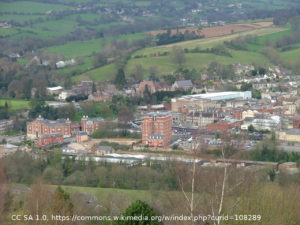
Since the 1990s Stroud in Gloucestershire has taken this bull by the horns. In 2015 it became the first local authority in Europe to become carbon neutral. As well as undertaking domestic energy efficient retrofits it has fitted solar panels to houses and all municipal buildings. Residents are feeling the difference and spending less on energy bills.
Collaboration
Its grade II listed council building has secondary glazing and internal insulation and sources all heat from renewables. Through collaboration with other local authorities Stroud has boosted recycling rates to 61%.
It has plans for more. It wants to become a carbon neutral area by 2030, 20 years ahead of the government’s target. It will do this by using electric vehicles, making all homes (that’s ALL homes) energy efficient, using low- to no-carbon electricity and heat generation and tree planting. It’s aiming to facilitate cycling, walking and renewable-powered public transport. At this rate Stroud will also become one of the healthiest local authorities in England.
Simon Pickering, a Green party councillor and chair of the council’s environment committee, makes the point:
“It will no longer be business as usual to cut the energy use of all buildings by at least 80%, generate over half the district’s electricity needs from renewable sources and transform how we travel.”
And this is the point, serious policy shift must be implemented by an authority wanting to see results.
However Stroud and other authorities including Nottingham and Oxford are the bold few. Despite widespread announcement of climate crisis among local authorities in the UK many take an illogical approach to carbon reduction. Manchester’s plans for carbon neutrality explicitly exclude emissions from aviation. In Norwich and Hereford there are road-building plans. In Hereford in particular these plans have been heavily criticised for not tackling the real cause of congestion – short city centre journeys that could be replaced by public transport or walking and cycling infrastructure. Going even further, Cumbria County Council has approved opening a new coal mine. This is another example of the postcode lottery at work in the UK.
Ground Source Heat Pumps
Heat pumps are used in about 100,000 homes in the UK. In Sweden, Germany, Switzerland and the USA they’ve been widely used for years.
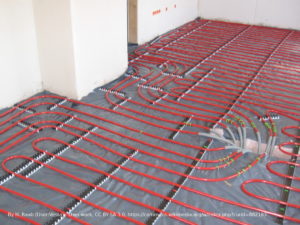
Ground source heat pumps (and their near relations air and water source heat pumps) have become the heating method of choice for low-energy builds. This is for two main reasons. Firstly, although they need electricity to run, the heat the pumps draw in is continually and naturally renewed. Secondly, heat pumps work best in a house with levels of insulation and draught-proofing well above average. Due to its lower temperatures a heat pump system tends to work best with under-floor heating and warm air heating systems.
How it works
The temperature a couple of meters below ground stays at around 8-12 degrees all year round. A ground source heat pump extracts this heat through buried loops of pipe about 100m long. The pipe has a mix of water and antifreeze flowing through it. This liquid absorbs heat from the ground and passes it through a heat exchanger to increase its temperature to about 50 degrees. This warmth heats water and heating circuits in the house. The liquid then flows back out into the pipes buried in the ground and the cycle goes on continuously.
If the electricity drawn by a house running a heat source comes from renewables, then this method of heating is very environmentally friendly. According to the Ground Source Heat Pump association website, each unit of electricity used by a heat pump generates 3-4 units of heat. They put this in terms of a well-fitted heat pump achieveing 300-400% efficiency. This beats low-carbon emitting gas heating, with 70% lower CO2 emissions.
Is it right for you?
As with the other methods of heating we’ve looked at, this depends on a few things. The heat supplied tends to be constant but lower than we’re used to with standard gas or oil heating. There are no scalding radiators. This is why a house deriving its heat from a heat pump needs to be insulation and draughtproofed to such a high level. A house not so well insulated and airtight may need additional heating, which will cost money and may produce emissions.
Geology
Designing the best set-up for your home requires professional input. There are a number of variations of how a ground source heat pump system can be configured. For instance, if you have the room your external pipework with be buried in a trench up to a couple of metres deep in the garden. This is usually the cheaper option for small smaller systems. If you don’t have the space then a vertical bore can be sunk instead up to about 160m deep. Vertical installations can reach higher ground temperatures. The cost of sinking a borehole can vary hugely depending on where you live. The exact size or depth of trenches need to be assessed by the professional who will take into account local geology (for instance, clay holds more heat than sand). They will consider for instance how big the house is and your heating and hot water requirements. If this isn’t caried out properly or there are any issues with the installation then there may be problems with how well the system performs.
Fitting a ground source heat pump and associated heating is expensive. According to Which it can be less efficient if it’s providing hot water as well as heating. The end of the system fitted in the house can be as big as a filing cabinet, depending on which kit you choose. It’s very long-lasting though and requires inexpensive maintenance. The Energy Saving Trust suggests a yearly check by the householder and a professional check every 3-5 years. There are no safety issues and some elements of the set-up are said to last up to 100 years. Your heating bills will be very low. If it’s fitted as part of a build or refurbishment the disruption will be less and costs can be combined.
Although the government has tinkered with tariffs lately, heat pump heat is eligible for the Domestic Renewable Heat Incentive (RHI). Additionally, ICAX, which describes itself as “a cleantech company”, says,
“The planning authorities like ground source systems as they are safe, silent, invisible heating systems with low environmental impact.”
Controls
According to an Energy Saving Trust PDF download on getting the best from your heat pump, the controls can be complex. If you don’t master them the heating may not work to optimum. Its own research suggests that this is something householders do struggle with.
The basic controls comprise an adjustable controller, and a room thermostat. The controller has a number of functions and is typically sited on a wall near to the pump’s installation spot. It manages flow, temperatures of different aspects of the system, allows you to set timings and displays error messages. The thermostat monitors temperatures to make sure they stay within comfortable limits. It communicates with the heat pump if temperatures do get too low.
RHI
According to the website of Kensa Heat Pumps, the Domestic RHI is intended for private self-builders and homeowners, acknowledging perhaps that you don’t simply fit a heat pump system into any old house. Currently the Domestic RHI pays out once a quarter for seven years. It pays out 20.46p per kWh with funding secure for new applications to 2020. The exact amount each applicant receives is worked out by an accredited installer. It involves the SCOP – seasonal coefficient of performance. This is the ratio of the energy the pump needs to work, to the heat produced.
An article on the website Homebuilding&Renovating, Ground Source Heat Pumps: Ultimate Beginner’s Guide, includes several photos of an installation, to give you an idea of what’s involved. Suffice to say, you need room for a digger.
Energy efficiency in the leisure sector
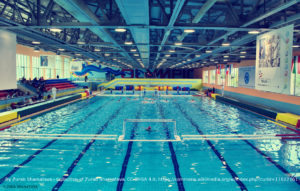
Leisure centres and sports stadia usually include big open spaces with lots of equipment. From olympic-size swimming pools to gyms, there are big spaces of heat and lots of kit to run. Aside from travel, venues often supply food and drink. Some provide showering facilities and treatments. There is the potential to use vast amounts of power and run up an oversize carbon footprint. We’ll be revisiting this subject so if you know of a good example or have a project to share please get in touch.
According to a Carbon Trust PDF, Sports and leisure, Introducing energy saving opportunities for business, energy costs are second only to staff costs for a leisure centre. At 30% of running costs this is higher than in most other sectors. In common with other sectors though are the trouble spots: heating, lighting and electrical equipment.
Simple measures
The Carbon Trust starts with recommending simple measures such as turning off equipment not in use, maintaining equipment, and planning energy efficiency refurbishments along with regular work. It goes on to look at how heating matches variable occupancy. This can be controlled through time switches and keeping it under review. It makes the slightly eye-rolly point that:
“Many systems function inefficiently becausesomeone made a short-term adjustment and then forgot about it.”
As buildings cool down slowly, the PDF recommends turning heating off an hour before the centre closes. These sound small and obvious, but they make a difference. Implemented in similar settings across the country would amount to a chunk off emissions.
Widely applicable
Much of the advice in the PDF is applicable to all sorts of buildings and businesses. It emphasises the use of natural light, making sure windows are kept clean. It recommends a revolving door to prevent cold air blowing in during the colder months. Sensor lighting is recommended for loos and little-used areas. A pool cover can reduce the costs of heating a pool by up to 30%. There isn’t a great deal about running a leisure centre that’s different to running any other type of setting, but with energy consumption so high there are many areas where improvements can be made.
Leisure Energy is company helping leisure centres make these improvements. Reading up on their work with Brecon Leisure Centre, not only do they design and project manage the works, but they check that the projected savings are being achieved. They also train staff in energy conservation. Without both of these measures, energy efficiency works run the risk of being a tick box exercise that don’t make nearly the difference that they could.
Works at Brecon included replacing a worn-out air handling unit kit with energy efficient model. As well as reducing energy consumption the improved unit gave the leisure centre more control over the function. Low energy lighting was installed. It saved money and improved light levels. This demonstrates that energy efficiency works often come with other benefits. Improving facilities while reducing emissions and maintenance, and saving money, is a win win win. Win.
Rugby

Rugby has been looking at how to improve energy efficiency and sustainability. There had been action on a case-by-case basis, but this was fragmented. Moves weren’t aligned, and results weren’t what they could have been. Last year, World Rugby published a sustainability framework. To quote World Rugby:
“Environmental initiatives included reassessing tender and host selection requirements for competition and event hosting. Guidelines were put in place to reduce/reuse/recycle signage, clothing and equipment, promote the use of teleconference facilities to reduce the impact of travel, provide cycle-to-work facilities and promote smart energy usage to create energy-efficient workplaces.”
On its website, World Rugby defines sustainability as “putting in more than you take out”, which isn’t a bad approach to life. World Rugby acknowledges that with a global game and international competitions, there is the issue of travel. It remains a work-on. There’s a willingness however to keep the game sustainable and to take steps to minimise its environmental impact in the areas where it can.
Its sustainability plan includes all the standard measures you would expect. Caterers are expected to avoid single use plastics, operate high standards of food sourcing with minimal food miles and reduce food waste. Players and fans are urged to travel light, cycle or use public transport. Best practice is urged in accommodation, eg re-using towels. 20 teams with 32-man world cup squads plus all the hangers-on, fans and officials adds up to a lot of towels. Teams are urged to double up in rooms (some do this already), and to stay near their venues to reduce travel.
Glasgow Warriors
These and more are however only suggestions. So are there any examples of teams really putting their backs into energy efficiency? Pro14 team Glasgow Warriors have promoted good practice at their stadium Scotstoun in several ways. Partnering with First Bus, fans can travel to the stadium for free on a matchday. Scotstoun is in a built-up area of Glasgow, so this reduces traffic and the associated emissions. It also helps to keep local residents on-side.
Rugby isn’t rugby without a pie and a pint. At Scotstoun most food packaging is compostable. See that? Compostable, not recyclable. The club wants all matchday food and drink packaging to be compostable or recyclable. The gound encourages recycling with colour-coded bins. The manager and players have been roped in to making videos encouraging fans to use the bins. 560 kilos of waste collected from just four matches alone was diverted from landfill.
MD of the Warriors, Nathan Bombrys, wants the club to be a positive influence on its home city.
Stadium design
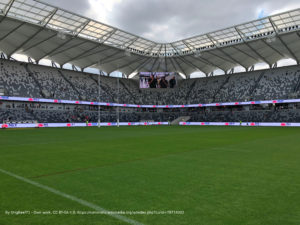
In Australia, a new stadium will be powered by renewable sources. The Bankwest Stadium in Parramatta, a suburb of Sydney, has been built to LEED standards – leadership in energy and environemtal design. It will be lit by the lastest LED technology which will significantly reduce energy use. This is part of the New South Wales government’s policy of rebuilding major venues to climate proof them against extreme weather.
Antalya football stadium is Turkey’s first solar-powered stadium. 75% of the roof’s 16,000 sq m is covered in solar panels. These 6000 panels supply power away from the stadium when it’s not in use. Looking around at energy efficiency measures in stadia, solar energy pops up again and again. A multi-sport venue in Las Vegas, the T-Mobile Arena, is another using high-efficiency LED lighting. It also has energy efficient heating systems and has reduced its use of water and cooling energy. These measures together have won it a gold LEED certificate. It’s the first Las Vegas building to win one.
Football
An article on the Selectra website looks at how much energy was used during last year’s football World Cup in Russia. In a 90 minute match enough power is consumed by a stadium to power at least 12 houses for a year. In a cold country such as Russia extra heating is used for keeping the pitch defrosted and in some cases to warm seats. FIFA has standards for even pitch illumination, which together with scoreboards and advertising accounts for 40% of the energy used in a game. Many of the 80,000 spectators want food and drink, so catering gobbles up another 20%. Broadcasting the match to the world takes 10%. Add in the power required for hordes of football fans to enjoy the match at home with cold beer and hot pizza, and the power drawn for watching just one football match is hair-raising.
Sitting in a stadium is the most environmentally-friendly way to watch a match, unless of course you’ve flown from the UK to Russia. The next best is to watch it in the pub – one TV, one setting to keep warm, one kitchen cooking the food.
Passive Cooling
Passive cooling is an element of low-energy building design. It works either by preventing heat building up, or removing it naturally. Natural cooling works by combining naturally-available energy and heat sinks – the sky, the atmosphere and the earth – with good design, rather than mechanical methods. Since 2000 the energy used to keep buildings cool has doubled, equating to almost the entire electricity production of Europe in 2016. Cooling is the fastest-growing end-use for energy in buildings.
Climate and microclimate are central considerations. Humid environments require something different from a hot and dry area. Humid places can be the hardest to cool effectively. In these cases many small openings in the building is more effective than a couple of large ones, to catch and optimise any breeze there might be. Some areas have a significant temperature change between night and day. Cool night air can come in at night and be trapped in during the day. Some countries are a similar temperature all year round, others have contrasting seasons. All this needs to be taken into account when designing the right passive cooling for any building.
Shading
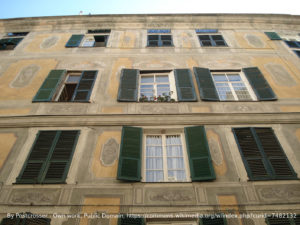
Shading minimises solar heat gains, while careful building layout and orientation planning will allow heat to build up where’s it most wanted. Orientation can for instance take into account the prevailing wind, to maximise breezes through the building. Insulation, usually considered in the UK to be about keeping heat in, can also keep it out by minimising heat transfer.
Shades or awnings can be retrofitted to almost any style of house to reduce solar gain in an overheating room. As they can be ‘out’ doing their job, or rolled or folded away at other times, they are a flexible approach that can be operated just in the rooms where you need them. Consider how often you see shutters on mediterranean buildings. They help to insulate in cold weather too, so maybe we’ll see them fitted more widely in the UK as summers get hotter.
Green roofs
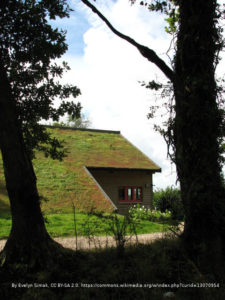
A New Zealand website from the Ministry of Business, Innovation and Employment, Hikina Whakatutuki, provides lots of advice on passive cooling. It suggests painting the roof white to reflect sunlight, and insulating the roof space to prevent heat building up in the roof space filtering down into the house.
An alternative to a white roof is a green roof, or a living roof. A green roof consists of vegetation planted over a waterproof membrane. Some green roofs incorporate ponds to treat greywater, and others – not for the purist – include plants in containers. A green roof can be retrofitted to a house as well as incorporated into new build. They can be provide insect habitat, lower urban air temperatures and work against the heat island effect. Living walls do a similar job on the vertical. We’re trying something similar, in a small way, to cool our office. It gets the sun all afternoon and can become very hot and stuffy.
We’ve constructed a ledge around a chickenwire frame and put climbing plants in pots on the ledges. The idea is that as the plants grow they will shade the office. We’ve planted several varieties of peas and beans, as fast climbers, so we get a small harvest too. We’ll look more closely at green roofs and living walls another time, as they’re quite fascinating.
Fountains, ponds, planted pergolas and so on all make a difference.
PCMs
Research has been ongoing in hot countries such as Chile and Malaysia into phase change materials (PCMs), including glycerine, wax oandwater. These absorb heat when the air around them is hot and become liquid, then emit it when the temperature falls and they solidify. There are all sorts of permutations of materials, temperatures and environments under research, but PCMs do look to have some effect.
Australia has been active in promoting passive cooling measures across all its zones. It recognises the enormous demand that can be placed on electricity when a heat wave hits and thousands of homes ramp up the air conditioning for a few days. There is a great deal of information available online from the Australian government, but one piece of advice leapt out:
“Conduction contributes to…comfort and involves body contact with cooler surfaces. It is most effective when people are sedentary (e.g. sleeping on a water bed).”
Energy Saving Product of the Week
Well after that, it has to be window blinds. Consider whether your blind is primarily to keep out heat or cold, or whether it does both at different times of year. Blinds can be metal, plastic, wood or cloth, slatted, vertical or horizontal. There are low-tech and hi-tech, internal and external.
If you’re struggling with keeping a room a comfortable temperature look at the role the window is playing in thermal gain or loss. Blinds can be professionally measured up and produced, or bought cheaply from a DIY shop. If you’re cooking in the summer and freezing in the winter, it’s worth examining how blinds could help.
What are we up to? We delivered new Petflap stock to the warehouse yesterday, including special orders. We continue to improve our range of photos, and will be including photos with added cats to our online galleries soon. If you’re wondering whether your cat will fit through the Petflap, do we have a treat for you! You can download a life-size pet access flap PDF from our site, cut out the aperture and see whether your cat or dog will fit through.
Thank you for listening to episode 7 of the Energy Efficiency Podcast, available through Apple Podcasts. If you like your podcasts with pretty pictures, a video version is available on YouTube – look for the Ecoflap channel where we also have product videos. Until next time you can find us on both Twitter and Instagram as Ecoflap, and on Twitter we also tweet under The Petflap. In next week’s episode we’ll look at green roofs, solar heating and energy efficiency in medicine. Bye.
Music credit: “Werq” Kevin MacLeod (incompetech.com)
Licensed under Creative Commons: By Attribution 3.0 License
http://creativecommons.org/licenses/by/3.0/
